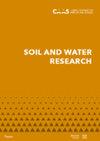生物炭对白垩粘土露露醇土壤特性和细菌群落的影响
IF 1.7
4区 农林科学
Q4 SOIL SCIENCE
引用次数: 2
摘要
在这项为期四年的研究中,我们重点研究了生物炭施用对白色粘土Luvisol土壤理化性质(土壤全碳、全氮、全钾、全磷、有效氮、有效钾、有效磷、pH、容重和水分)和细菌群落的影响。在试验开始时,生物炭只施用一次,施用量分别为0、10、20和30 t/ha。土壤样品采集于4年后的表层(0 ~ 10 cm)和第二层(10 ~ 20 cm)土层。结果表明:随着生物炭的施用,土壤总碳(TC)和pH升高,土壤容重(BD)降低;利用Illumina MiSeq方法测定的土壤细菌序列显示,施用生物炭后,酸性菌的相对丰度降低,放线菌的相对丰度增加。施用生物炭对细菌多样性有显著影响。非度量多维标度(NMDS)和典型对应分析(CCA)表明,土壤细菌群落结构受生物炭添加量和土壤深度的影响。Mantel试验分析表明,土壤细菌群落结构仅与pH (r = 0.525, P = 0.001)、容重(r = 0.539, P = 0.001)和TC (r = 0.519, P = 0.002)显著相关。第二深层土壤性质、细菌相对丰度和群落组成的差异大多大于表层。本文章由计算机程序翻译,如有差异,请以英文原文为准。
The impacts of a biochar application on selected soil properties and bacterial communities in an Albic Clayic Luvisol
In this four-year study, we focused on the impacts of a biochar application on physicochemical soil properties (soil total carbon, total nitrogen, total potassium, total phosphorus, available nitrogen, available potassium, available phosphorus, pH, bulk density and moisture) and bacterial communities in an Albic Clayic Luvisol. The biochar was applied to plots only once with rates of 0, 10, 20 and 30 t/ha at the beginning of the experiment. The soil samples were collected from the surface (0–10 cm) and second depth (10–20 cm) soil layers after four years. The results showed that that the soil total carbon (TC) and pH increased, but the soil bulk density (BD) decreased with the biochar application. The soil bacterial sequences determined by the Illumina MiSeq method resulted in a decrease in the relative abundance of Acidobacteria, but an increase in the Actinobacteria with the biochar application. The bacterial diversity was significantly influenced by the biochar application. The nonmetric multidimensional scaling (NMDS) and canonical correspondence analysis (CCA) indicated that the soil bacterial community structure was affected by both the biochar addition and the soil depth. The Mantel test analysis indicated that the bacterial community structure significantly correlated to a soil with a pH (r = 0.525, P = 0.001), bulk density (r = 0.539, P = 0.001) and TC (r = 0.519, P = 0.002) only. In addition, most of the differences in the soil properties, bacterial relative abundance and community composition in the second depth soil layer were greater than those in the surface soil layer.
求助全文
通过发布文献求助,成功后即可免费获取论文全文。
去求助
来源期刊

Soil and Water Research
Water resources, Soil Science, Agriculture-WATER RESOURCES
CiteScore
4.60
自引率
0.00%
发文量
26
审稿时长
>12 weeks
期刊介绍:
An international peer-reviewed journal published under the auspices of the Czech Academy of Agricultural Sciences and financed by the Ministry of Agriculture of the Czech Republic. Published since 2006.
Thematic: original papers, short communications and critical reviews from all fields of science and engineering related to soil and water and their interactions in natural and man-modified landscapes, with a particular focus on agricultural land use. The fields encompassed include, but are not limited to, the basic and applied soil science, soil hydrology, irrigation and drainage of lands, hydrology, management and revitalisation of small water streams and small water reservoirs, including fishponds, soil erosion research and control, drought and flood control, wetland restoration and protection, surface and ground water protection in therms of their quantity and quality.
 求助内容:
求助内容: 应助结果提醒方式:
应助结果提醒方式:


